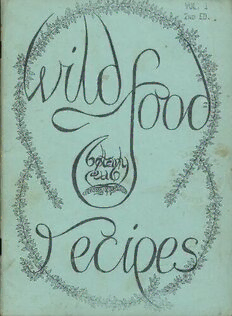
Wild food recipes PDF
Preview Wild food recipes
The Botany Club is proud to present this booklet of recipes for use with wild ingredients. The members of the club compiled this edition after testing them successfully at a "Wild Tea Party" which actually turned out to be a "Wild Feast". We use the term "wild food" to include Australian native plants as well as introduced plants which have gone wild (i.e. weeds). However, the recipes are essentially European style and contain conventional ingredients to support the wild flavours. Having tried the recipes in this booklet, you may find you can adapt many of your own favourite recipes by simply experimenting with some of the equivalent wild foods. For information regarding the edible wild plants and their distribution, we refer you to the book: "Wild Food in Australia" by A.B. and J.W. Cribb (Published in 1975, Collins: Sydney and London, 240pp). The Botany Club accepts no responsibility for the consequences of misidentification of ingredients by the reader, neither can responsibility be accepted for the use by the reader of varieties within species mentioned in this booklet, that are unknown to the Botany Club. It is very important that only those species listed as safe be used and that due attention is paid to guidelines given in this booklet for the preparation of food, such as use only the rips fruit. 5 ACACIA (Wattle) Acacia Pikelets: Wattle pollen of any species 2 eggs 1/2 cup sugar pinch of salt 1 cup of milk 2 level teaspoons of cream of tartar l½ cups of flour 1 level teaspoon of baking soda Beat lightly as for a sponge cake for about 10 minutes, 2 eggs, 1/2 cup sugar and a pinch of salt. Then add 1 cup of milk; sift l½ cups of flour, baking soda, cream of tartar and liberal amounts of Acacia pollen. Mix lightly and spoon onto a hot frying pan greased with butter. 6 ACAENA ANSERINIFOLIA (Bidgee Widgee, Buzzy) Can be used as a substitute for tea but considerably more leaves are required than would be used in making tea. ACMENA SMITHII (Lillypilly) Purplish fruits while edible are of poor quality. ADIANTUM (Maiden Hair Fern) Can be used dried or fresh. Pour 2 quarts of boiling water over 4 ozs of fern leaves, cover closely and allow to cool. Was once used as a cure for colds. 7 ALPINIA CAERULEA (Wild Ginger) Found at the margins of rainforests. Young tips of underground stems have a distinct ginger flavour. This species has blue fruits with a scanty but pleasantly acid pulp. Seeds can be eaten raw. Stems can be finely chopped and boiled in syrup to use as a dessert topping. ARAUCARIA BIDWILLII (Bunya Nut Pine) Bunya pine was a common tree in rainforests of southeast Queensland. Nuts can be eaten raw, roasted or can be ground into a flour. When camping, boiling is the best method of preparation as nuts roasted in a camp fire frequently explode but by either method they are delicious when eaten hot. The kernel is starchy with the texture of a waxy boiled potato with a slightly resinous flavour. 8 AURICULARIA POLYTRICHA (Hairy Jews Ears) This species is found on decaying wood, usually in rainforests, mangroves and moist forests. Cloud Ears, Chinese Style: 1/2 cup dried fungus 2 teasp. hoi sin sauce 1/4 cup water 1 teasp. sesame oil 2 tabsp. soy sauce 1 clove garlic (crushed) 2 teasp. vegetable oil 1 teasp. cornflour mixed with 1 tabsp. water Soak fungus for an hour in large quantity of hot water. Clean, trim and cut to bite size pieces. Heat oils, fry garlic for 1 minute then add the fungus, soy sauce, hoi sin sauce and water. Bring to boil, keeping stirred and then thicken with the cornflour mixture. Served usually as part of a Chinese meal with noodles or rice.
